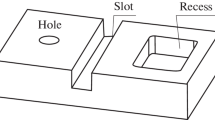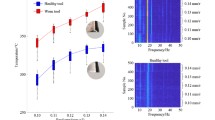Abstract
This paper discusses the application of neural network-based pattern recognition techniques for monitoring the metal-cutting process. The specific application considered is in-process monitoring of the condition of the cutting tool. Tool condition monitoring is an important prerequisite for successful automation of the metal cutting process. In this paper, we demonstrate the application of supervised and unsupervised neural network paradigms to pattern recognition of sensor signal features. The supervised technique used is backpropagation and the unsupervised technique used is adaptive resonance theory (ART). The results support the premise that, despite excellent classification accuracy by both networks, the unsupervised system holds greater promise in a real world setting. The advantages are discussed and a framework for exploiting them in tool condition monitoring systems is presented.
Similar content being viewed by others
References
Anderberg, M. (1973)Cluster Analysis for Applications, Academic Press, New York.
Andrews, G. and Tlusty, J. (1983) A critical review of sensors for unmanned machining.Annals of the CIRP,32, 563–72.
Barash, M. (1980) inComputer Integrated Manufacturing Systems, Kops, L. (ed.) ASME New York, pp. 37–50.
Burke, L. I. (1989)Automated identification of tool wear states in machining processes: an application of self-organizing neural networks, PhD thesis, University of California, Berkeley.
Burke, L. I. (1991) An unsupervised neural network approach to tool wear identification.IIE Transactions, in press.
Carpenter, G. A. and Grossberg, S. (1987) ART2: self-organization of stable category recognition codes for analog input patterns.Applied Optics,26, 4910–46.
Devijver, P. and Kittler, J. (1982)Pattern Recognition — A Statistical Approach. Prentice Hall, New Jersey.
Dornfeld, D. (1986) Acoustic emission monitoring for untended manufacturing, inProceedings of Japan-USA Symposium on Flexible Automation, JAACE, Osaka.
Dreyfus, S. E. (1989) Artificial neural networks, back propagation, and the Kelley-Bryson gradient procedure.Unpublished paper.
Grossberg, S. (1976) Adaptive pattern classification and universal recoding: I, Parallel development and coding of neural feature detectors.Biological Cybernetics,23, 121–34.
Grossberg, S. (1987) Competitive learning: from interactive activation to adaptive resonance.Cognitive Science,11, 23–63.
Hamstad, M. and Mukherjee, A. (1974) The dependence of acoustic emission on strain rate in 7075-T6 aluminum.Experimental Mechanics,January, 33–41.
Hatano, H. (1975) Quantitative measurements of acoustic emission related to its microscopic mechanisms.Journal of the Acoustical Society of America,57, 639–45.
Iwata, K. and Moriwaki, T. (1977) An application of acoustic emission to in process sensing of tool wear.Annals of the CIRP,26, 21–6.
Kannatey-Asibu, E. and Dornfeld, D. (1981) Quantitative relationships for acoustic emission from orthogonal metal cutting.ASME Journal of Engineering for Industry,103, 330–40.
LeCun, Y. (1985) A learning procedure for asymmetric threshold networks, inProceedings of Cognitiva, Paris.
Lippmann, R. (1987) An introduction to computing with neural, networks.IEEE ASSP Magazine,4, 4–21.
MacQueen, J. B. (1965) Some Methods for Classification and Analysis of Multivariate Observations, inProceedings of the Fifth Symposium on Mathematical and Statistical Probability, Berkeley, University of California Press, Berkeley, pp. 281–97.
Micheletti, G. F., Koenig, W. and Victor, H. R. (1976) In process tool wear sensors for cutting operations.Annals of the CIRP,25, 483–94.
Rangwala, S. (1988) Machining Process Characterization and Intelligent Tool Condition Monitoring using Acoustic Emission Signal Analysis, PhD thesis, University of California, Berkeley.
Rangwala, S. and Dornfeld, D. (1988) Integration of Sensors via Neural Networks for Detection of Tool Wear States, inProceedings of the Winter Annual Meeting of the ASME,PED 25, 109–20.
Rangwala, S. and Dornfeld, D. (1990) Sensor integration using neural networks for intelligent tool condition monitoring.Transactions of the ASME, Journal of Engineering for Industry,112, 219–27.
Rumelhart, D. and McClelland, J. (eds) (1986)Parallel Distributed Processing I. MIT Press, Cambridge, MA.
Rumelhart, D. and Zipser, D. (1985) Feature discovery by competitive learning.Cognitive Science,9, 75–112.
Taylor, F. (1906) On the art of cutting metals.Transactions of the ASME,28, 31.
Author information
Authors and Affiliations
Additional information
This work was completed as part of graduate research at University of California, Berkeley, Department of Mechanical Engineering.
Rights and permissions
About this article
Cite this article
Burke, L.I., Rangwala, S. Tool condition monitoring in metal cutting: A neural network approach. J Intell Manuf 2, 269–280 (1991). https://doi.org/10.1007/BF01471175
Received:
Accepted:
Issue Date:
DOI: https://doi.org/10.1007/BF01471175




